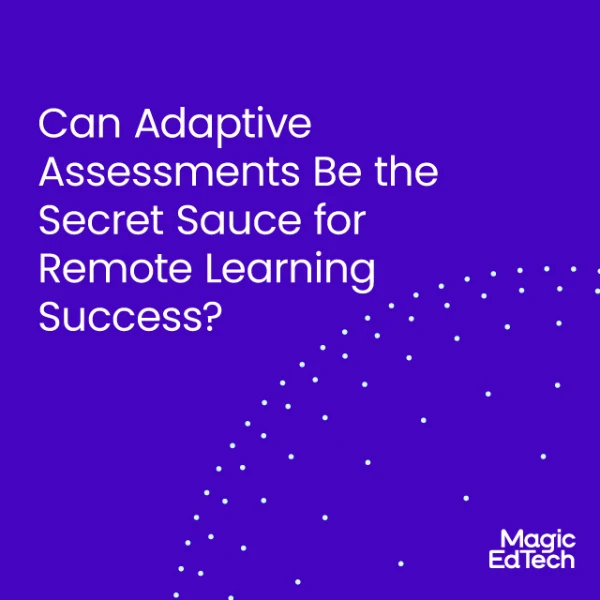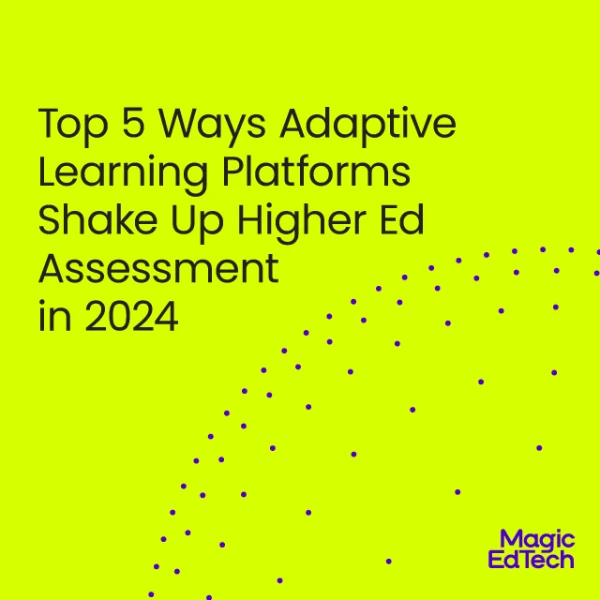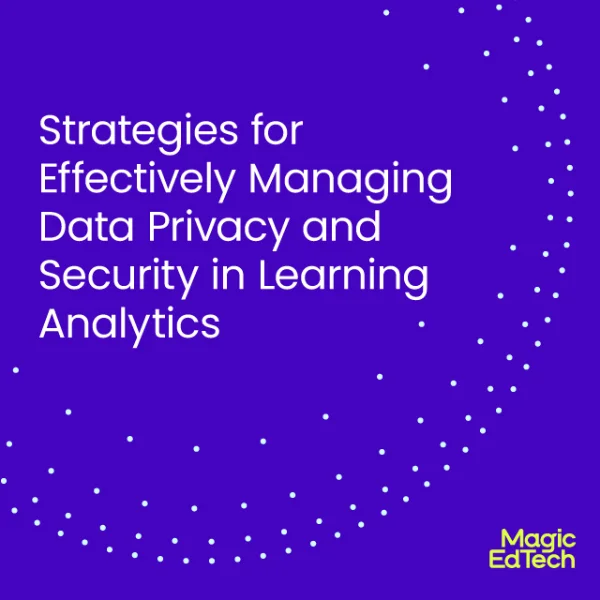Predictions to Personalization in Higher Ed with AI-Powered Analytics
- 25 August, 2023
- Reading Time: 7 mins
Today, higher education institutions understand that staying ahead requires more than just traditional teaching methods. They are constantly finding ways to harness the power of Artificial Intelligence (AI) and Machine Learning (ML) to predict and prescribe solutions that drive success.
But what drives this transformation? Predictive and prescriptive student success analytics! They offer insights that can significantly improve learning outcomes. So, let’s explore the key differences between predictive and prescriptive analytics, understand their role in education, and shed light on the data and technology driving this change.
Story Time
Before we dive into the details, here is a small story to bring you up to speed about the topic of discussion here.
Emily is a first-year student who has just started her higher education journey. Her University utilizes AI-powered analytics to enhance the learning experience for its students.
As Emily navigates through her courses, the system discreetly tracks her interactions with the following:
- Online learning materials
- Attendance records
- Quiz scores
- Participation in discussion forums
This is where you can see predictive analytics in action. They analyze her data along with that of previous students to predict potential challenges she might face. By identifying patterns, the AI system foresees when a student like Emily might struggle with a particular subject or concept.
So, when the learning data shows a slight drop in her quiz scores and a decrease in her participation, the predictive model raises an alert, prompting her academic advisor to intervene.
The AI system doesn’t just stop at predictions—it also suggests actionable steps. Emily’s advisor recommends setting up a virtual meeting with her to discuss her challenges and offer support.
During the meeting, Emily expressed her concerns about a specific math module. Armed with insights from the AI system, the advisor provides her with a personalized study plan. This plan includes additional practice exercises, access to online tutoring resources, and a weekly check-in to track her progress.
These actions help in creating a customized learning journey for Emily. The AI system monitors her interactions when she starts following this study plan. It tracks her engagement with the supplementary materials, time spent on each concept, and quiz retake scores. This information helps the system fine-tune her study plan in real-time. For instance, when Emily improves in certain areas, the system adapts and recommends more advanced materials to challenge her further.
In a matter of months, Emily’s performance improved significantly. Her quiz scores are consistently higher, and her participation in discussions has increased. Thanks to the timely intervention and personalized support provided by AI-powered analytics, Emily’s learning journey has turned positive. By onboarding a streamlined learning analytics platform, her institution reports a hike in student performance, reflecting the success of its data-driven approach.
But how does educational technology help the institutions? Emily’s story exemplifies how AI-powered analytics can transform education. By identifying struggling students early and offering tailored interventions, institutions can:
- Foster a culture of student success
- Contribute to the overall institutional success
- Create higher retention rates
- Generate improved student satisfaction
- Yield an enhanced academic outcome
These are just some of the outcomes institutions can achieve through the strategic use of AI-powered analytics.
Now that you understand the importance of AI-powered analytics let’s look at how it transforms higher education.
Understanding Predictive vs. Prescriptive Analytics
In higher education, the terms “predictive analytics” and “prescriptive analytics” often come up in discussions about leveraging data for student success. While they both play integral roles in harnessing the power of AI and machine learning, they serve distinct purposes that contribute to the overall goal of enhancing learning outcomes. Let’s delve into the key differences between predictive and prescriptive analytics:
Predictive Analytics: Illuminating Future Possibilities
Predictive analytics involves analyzing historical data to identify patterns and trends that can be used to make informed predictions about future events. In the context of higher ed, predictive analytics aims to foresee potential challenges that students might face during their academic journey. By scrutinizing factors like online interactions, attendance records, quiz scores, and more, institutions can identify early warning signs that a student might be struggling.
For instance, in our earlier story about Emily, her University’s AI-powered system utilized predictive analytics to recognize a slight drop in her quiz scores and reduced participation in discussion forums. These trends, when compared to data from past students, triggered an alert that prompted her academic advisor to intervene. Predictive analytics can be likened to a weather forecast, providing insights into potential storms on the horizon. However, it’s the subsequent actions taken that truly make the difference.
Prescriptive Analytics: Guiding Action for Success
Prescriptive analytics goes a step beyond prediction. Once potential challenges are identified through predictive analytics, prescriptive analytics takes the wheel by providing actionable recommendations and strategies. It doesn’t just highlight a potential storm; it hands out an umbrella and a raincoat.
In Emily’s case, the prescriptive analytics system didn’t stop at raising an alert about her performance decline. It offered her academic advisor a set of steps to take. This involved setting up a personalized study plan that included additional practice exercises, online tutoring resources, and regular check-ins. Prescriptive analytics is all about crafting tailored solutions to address individual student needs, enhancing the probability of overcoming challenges and succeeding academically.
Predictive and Prescriptive Analytics in a Nutshell
Predictive analytics predicts what might happen based on historical data and patterns. It serves as an early warning system, alerting educators to potential issues. On the other hand, prescriptive analytics takes the predictions a step further, offering concrete recommendations and strategies to address those issues. While predictive analytics highlights the storm clouds on the horizon, prescriptive analytics provides the tools and guidance to weather the storm successfully.
In the context of higher education, the combination of these two analytics approaches can significantly improve learning outcomes. Predictive analytics identifies the need for intervention, while prescriptive analytics ensures that interventions are timely, personalized, and effective. This dynamic duo of analytics empowers educators to create a proactive, data-driven support system that fosters student success, transforming the educational landscape into a nurturing environment tailored to individual needs.
Transforming Predictive and Prescriptive Analytics With AI and ML
AI and ML are the driving force behind predictive and prescriptive analytics. These technologies analyze vast amounts of data quickly and accurately, identifying hidden patterns teachers might miss when working manually.
For example, AI algorithms can analyze students’ digital interactions with online learning platforms to gauge their level of engagement. This information can tailor content delivery, making learning more personalized and effective.
Changing the Learning Landscape
Predictive and prescriptive analytics can transform education as we know it. By identifying at-risk students early on, institutions can:
- Provide timely interventions
- Boosting retention rates
- Detect performance dips
- Recommend relevant resources
- Schedule manual intervention when needed
This level of personalized attention can significantly enhance student engagement and success rates.
Integrating Data and Technology Requirements
Institutions need access to various data sources to make accurate predictions and prescriptions. These include:
- Academic records
- Attendance data
- Online interactions
- Social and demographic information
This data needs to be seamlessly integrated using advanced technology. Custom learning analytics platforms are a perfect solution to integrate data from various sources and provide actionable insights.
These platforms enable institutions to create a holistic view of each student’s learning journey, facilitating informed decision-making.
Enhancing Learning Products and Platforms
The education technology landscape is all about leveraging predictive and prescriptive analytics effectively. Edtech companies and publishers must gather learning analytics to engage students and use the insights to enhance learning products and platforms.
For example, an Edtech company might use learning analytics in education to recommend the most suitable learning modules based on a student’s strengths and weaknesses. This enhances the student’s learning experience and sets the company apart in a competitive market.
Final Thoughts
We must accept that data-driven decision-making will be the norm in the future, and predictive and prescriptive analytics powered by AI and ML will change the face of education.
Higher education institutions, edtech companies, and publishers must seize the opportunity to embrace these technologies to foster student success. Do you want to transform your educational institution to be able to do the following:
- Identify struggling students
- Personalize learning experiences
- Optimize curriculum design
- Leverage the potential of predictive and prescriptive analytics in education
If yes, then the growth opportunities for your business are limitless. As the education landscape continues to evolve, those who harness the power of AI-powered analytics will undoubtedly lead the way toward a brighter and more prosperous future.
Partner with Magic EdTech today and get access to a robust platform that can transform into a feature-rich EdTech solution. Experience the potential of predictive and prescriptive learning analytics in higher education. We help you incorporate advanced learning analytics platforms that can empower your institution with actionable insights and drive unprecedented success.
For more information about our offerings, schedule a call with our experts right away!




